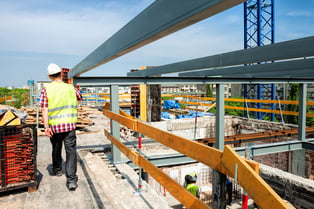Business owners, C-suite team members, and property owners – it goes without saying that you have navigated many storms thrown at you by the COVID-19 pandemic. It is likely you led your team through the government shutdown, implemented new safety programs to bring your team back to work, pivoted to find new revenue streams, and are now emerging out of this darkness stronger. Many industries, like construction and real estate, are still dealing with very raw COVID-19 supply chain pressures. If you aren’t looking to build a new building or purchase a new facility it would be easy to dismiss these issues as “not my problem.” After all, you may still have lingering COVID-19 fires you are still putting out that directly impact your own business. However, all businesses and property owners should pay close attention to the impact these construction supply chain issues could have on your business if you are faced with a natural disaster or accident in 2021 and beyond. Not addressing these concerns now could leave you underinsured or paying out-of-pocket in the event of a loss if replacement cost limits are not reviewed and updated to keep up with increasing building costs.
True confession - I am a recovering property underwriter. I spent more than a decade educating agents, brokers, and business owners on the importance of understanding and setting property limits to reflect the replacement cost value of each building. Replacement cost is often misunderstood and confused with market value. The market price of a building today does not equate to the cost to replace that same building with like, kind, and quality materials after a loss tomorrow.
Replacement cost as defined by IRMI:
Replacement cost is the cost to rebuild a physical structure after it is damaged from a peril like fire, flood, or wind. Replacement cost of a structure depends on many factors, however, hard costs such as millwork (windows, doors, and cabinets) and hardware (wood, steel, etc.) and soft costs such as skilled labor, general contractors, architects, and craftsmen are all part of the total cost equation.
According to IRMI, many unknown factors could cause the replacement cost of a structure to increase after a loss when the replacement cost estimate is being developed such as:
- Demand surge after a catastrophe
- Limited availability of skilled labor after a catastrophe
- Trends in materials costs
- Fluctuating fuel costs
COVID-19 Impact on the Construction Industry Supply Chain
The construction industry is working diligently to manage current supply chain challenges that have a direct impact on the cost to replace a building. The following year over year trends (2019 vs. 2020) were documented in the Corelogic Q4 Quarterly Construction Insights report:

- The cost of lumber has increased by 34%.
- The average annual cost increase for U.S. commercial building materials was 9.6%.
- Contractors reported material shortages of lumber, steel, and electrical products.
- Increasing labor costs across all occupations with roofers leading the charge at almost 6%.
These supply chain problems have continued to exacerbate construction costs well into 2021. Recent news headlines read:
“Wood Production hits 12-year high – but lumber prices are still up 171% since COVID started” – Fortune, March 31, 2021
“Home Depot charged four times more for some lumber products this year” – MarketWatch
“Lumber, Appliance Price Inflation Driving Up Construction Costs” – KathrynReed.com, May 10, 2021
While most property owners can decide to hold off on building a new facility until prices stabilize, business owners facing the challenge of rebuilding after a loss may not have that luxury. If replacement cost limits have not been reviewed and updated to align with these increasing cost trends, business owners could find themselves uninsured and paying high out-of-pocket costs after a loss. This makes reviewing and analyzing the replacement cost for your structure crucial.
You may be reading this and wondering what you can do to mitigate this from impacting your business. Here are a few strategies to help manage the replacement cost limit of your structure and reduce the chances of paying out-of-pocket in the event of a loss:
- The replacement cost limit should be a topic of conversation at every insurance renewal with your agent and carrier. It is also recommended to review the replacement cost limit after major events like a catastrophic loss or pandemic (I.E. COVID-19).
- Use your resources and tools available to you! As an underwriter, I used replacement cost estimating tools to help determine if a building was reasonably valued at a replacement cost limit. I shared and educated agents when the limit requested was not adequate according to the tool. It provides an opportunity to review, discuss and decide if a higher limit would be more prudent.
- Proactively get an on-site replacement cost appraisal of your building and contents. This provides insight specific to your risks and exposures to help you confidently set the replacement cost limit. Most underwriters will accept these independent third-party appraisals over the generic estimating tools all day long.
- Remember to include updates and renovations that could increase your structures’ replacement cost limit.
Implementing these strategies improves your chances of being made whole after a loss. Not taking a look at replacement cost limit annually, and now after the impacts of COVID-19, increases the chances you may be a financial contributor after a loss occurs.

COMMENTS